-
Spring Planting
Order now for best selections.
-
Fall Planting
Available for preorder for fall 2025 delivery.
-
Bulk Flower Bulbs
Big savings on bulk orders!
- New
-
Gardening Resources
Flower Bulbs & Perennials at Wholesale Prices

How to Care for Tulips
| Botanical Name | Tulipa |
| Plant Type | Flower bulb |
| Sun Exposure | Full sun to partial shade |
| Soil Type | Well-drained clay, loamy or sandy soils |
| Soil pH | Neutral to slightly acidic |
| Bloom Time | Early to late spring |
| Flower Color | Red, Pink, Orange, Yellow, Green, Purple, Bicolor, White |
| Hardiness Zones | 3, 4, 5, 6, 7, 8 |
| Special Features | Most tulips make outstanding cut flowers. |
Tulip bulbs are among the best-loved spring flower bulbs. Nothing says spring like a bright display of these classic, cup-shaped blooms. By planting a large swath of tulips, you can attain a natural-looking, Dutch-field appearance. K. van Bourgondien has a wide selection to choose from and years of experience cultivating quality tulip bulbs. Learn more about growing them and maintaining their care with this how-to guide.
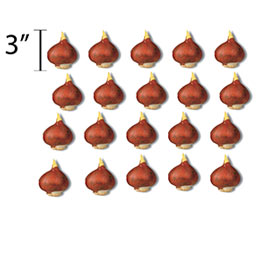
Tulip Bulb Planting Tips
Tulip bulbs should be planted in well-drained soil. You can improve the soil's drainage by working compost into the soil. The bulbs should be planted about 6" deep. A good rule of thumb is to plant them at a depth that's three times the bulb size. Space the bulbs about 6" apart. The bulbs should be planted pointy side up.
If you want to create a more naturalized look, scatter the tulip bulbs in a bed. Tulips are also stunning as border flowers.
While a shovel or trowel is great for digging, an auger and drill can make tulip bulb planting a lot easier. Both the Improved Bulb Auger and KneeSaver Planting Tool are time savers. Using an all-natural, slow-release fertilizer, like Van Bourgondien 100% Natural Bulb Food, at planting time can also give your tulips a boost.
When to Plant Tulips
Tulips are planted in the fall when the nighttime temperatures dip to 40-50 degrees Fahrenheit and several weeks before the first hard freeze. For northern gardeners, this is usually sometime in September or October. For southern gardeners, this is usually in November or December. The best time to order your tulip bulbs is late summer to early fall. Unique tulip varieties often sell out quickly, so ordering early is better.
Best Zones to Plant Tulips
Most tulips grow in hardiness zones 3-8. They're winter hardy in most temperate climates and suitable for many parts of the United States. You can find more information on growing zones at our zone finder page.
Tulips can be grown in full sun to partial shade. In northern climates they prefer full sun, while in hotter areas, they benefit from a bit of afternoon shade. When planting tulips, keep in mind that they bloom before many deciduous trees leaf out in the spring, so they can often be planted under trees.
How to Care for Tulips
Tulips, like other spring-flowering bulbs, are fairly easy to grow if you follow these tips on tulip care.
Common Problems with Tulips
While tulips are easy-care bulbs, they may have some problems caused by the environment, disease or pests. Here are some common problems with tulips and some tulip plant care tips.
Potting Tulips
Tulip flowers look stunning in pots--and it's easy to do if you follow a few tips.
Propagating Tulips
Tulips are most often propagated by dividing bulbs rather than from seed. Because most tulips are hybrids, propagating from seed often doesn't reproduce true. To propagate from bulbs, dig up the bulbs in the fall and break off the bulblets from the mother bulb. The bulblets can be replanted at a depth that is three times the diameter of the bulb. It may take a few years for the tulips to produce flowers.
Tulip FAQs
What are Common Tulip Pests?
Tulips may be bothered by aphids, mites, slugs, snails, mice and voles. Squirrels may dig up the bulbs.What are Common Tulip Diseases?
Common tulip diseases are bulb rot, root rot, gray mold and mosaic virus.How to Cut Tulips
To cut tulip flowers, use a sharp knife to cut the stems at an angle. Place the tulips in water immediately after cutting.What to do With Tulips After They Bloom
After tulips bloom, deadhead the flowers but leave the foliage for at least six weeks.How to Care For Tulips in a Pot
Tulips grown in pots are usually treated as annuals. If you want to try growing tulip bulbs in pots year after year, then fertilize the tulips after they finish flowering. When the foliage fades, remove the bulbs from the soil. After they dry, store in a cool place.How to Take Care of Tulips Indoors
Tulips grown indoors need about six hours of sunlight daily and should be watered 1 or 2 times a week.What do Tulips Represent?
Tulip flowers symbolize perfect love.Types of Tulip Flowers
When it comes to tulips you have many choices. The major factors to consider when selecting tulips are their bloom time (early spring, mid spring or late spring), flower color and form, and height. Below are some of the most popular tulip varieties.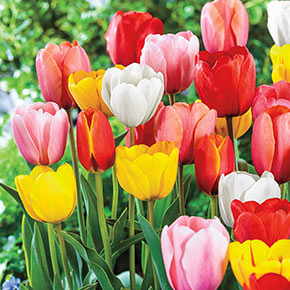
Darwin Hybrid Tulips—Feature traditional egg-shaped blooms, bold colors and long, sturdy stems. Blooming in mid to late spring, they're reliably perennial.
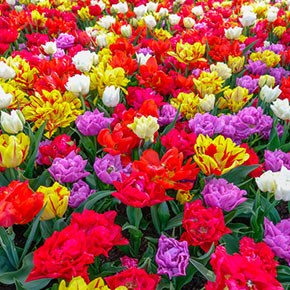
Double Flowering Tulips—Large, luxuriant blooms resemble peonies. Available in rich colors, they give gardens a unique look.
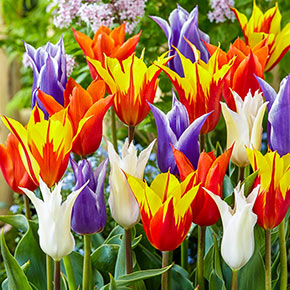
Lily Flowering Tulips—Give gardens a sophisticated, chic look. Available in bright hues, they look exceptional in borders and will draw the eye to the property.

Parrot Tulips—Flamboyant blooms feature vibrant splashes of color and fringed petals. These sought-after tulips are ideal for mass plantings where their flowers are appreciated even from a distance.
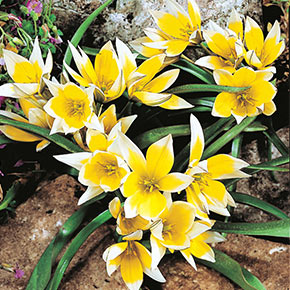
Species Tulips—Low-growing tulips with exotically shaped blooms bring flair to rock gardens and front borders. Early blooming variety looks best planted in groups and naturalizes well.
| Shop All Flower Bulbs | |
| See More Tips |
Have another question? Return to the Customer Service Help page or send an e-mail directly to Customer Service
Copyright © 2025 Gardens Alive!, Inc. d/b/a Dutchbulbs.com. All Rights Reserved. Dutchbulbs.com trademarks are registered trademarks of Gardens Alive!, Inc.
This site is protected by reCAPTCHA and Google Privacy Policy and Terms apply.
This site is protected by reCAPTCHA and Google Privacy Policy and Terms apply.

Item added to cart





